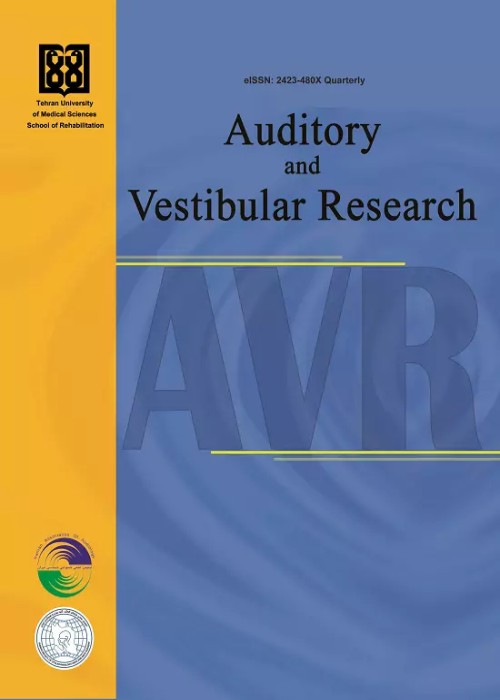Cochlear responses and auditory brainstem response functions in adults with auditory neuropathy/ dys-synchrony and individuals with normal hearing
Author(s):
Abstract:
Background And Aim
Physiologic measures of cochlear and auditory nerve function may be of assis¬tance in distinguishing between hearing disorders due primarily to auditory nerve impairment from those due primarily to cochlear hair cells dysfunction. The goal of present study was to measure of co-chlear responses (otoacoustic emissions and cochlear microphonics) and auditory brainstem response in some adults with auditory neuropathy/ dys-synchrony and subjects with normal hearing. Materials And Methods
Patients were 16 adults (32 ears) in age range of 14-30 years with auditory neu¬ropathy/ dys-synchrony and 16 individuals in age range of 16-30 years from both sexes. The results of transient otoacoustic emissions, cochlear microphonics and auditory brainstem response measures were compared in both groups and the effects of age, sex, ear and degree of hearing loss were studied. Results
The pure-tone average was 48.1 dB HL in auditory neuropathy/dys-synchrony group and the fre¬quency of low tone loss and flat audiograms were higher among other audiogram's shapes. Transient oto¬acoustic emissions were shown in all auditory neuropathy/dys-synchrony people except two cases and its average was near in both studied groups. The latency and amplitude of the biggest reversed co-chlear microphonics response were higher in auditory neuropathy/dys-synchrony patients than control peo¬ple significantly. The correlation between cochlear microphonics amplitude and degree of hearing loss was not significant, and age had significant effect in some cochlear microphonics measures. Audi-tory brainstem response had no response in auditory neuropathy/dys-synchrony patients even with low stim¬uli rates. Conclusion
In adults with speech understanding worsen than predicted from the degree of hearing loss that suspect to auditory neuropathy/ dys-synchrony, the frequency of low tone loss and flat audiograms are higher. Usually auditory brainstem response is absent in this patients and use of both otoacoustic emis¬sions and cochlear microphonics responses to measure cochlear hair cells function are suggested in them.Language:
Persian
Published:
Auditory and Vestibular Research, Volume:16 Issue: 1, 2007
Pages:
36 to 46
magiran.com/p506397
دانلود و مطالعه متن این مقاله با یکی از روشهای زیر امکان پذیر است:
اشتراک شخصی
با عضویت و پرداخت آنلاین حق اشتراک یکساله به مبلغ 1,390,000ريال میتوانید 70 عنوان مطلب دانلود کنید!
اشتراک سازمانی
به کتابخانه دانشگاه یا محل کار خود پیشنهاد کنید تا اشتراک سازمانی این پایگاه را برای دسترسی نامحدود همه کاربران به متن مطالب تهیه نمایند!
توجه!
- حق عضویت دریافتی صرف حمایت از نشریات عضو و نگهداری، تکمیل و توسعه مگیران میشود.
- پرداخت حق اشتراک و دانلود مقالات اجازه بازنشر آن در سایر رسانههای چاپی و دیجیتال را به کاربر نمیدهد.
In order to view content subscription is required
Personal subscription
Subscribe magiran.com for 70 € euros via PayPal and download 70 articles during a year.
Organization subscription
Please contact us to subscribe your university or library for unlimited access!


